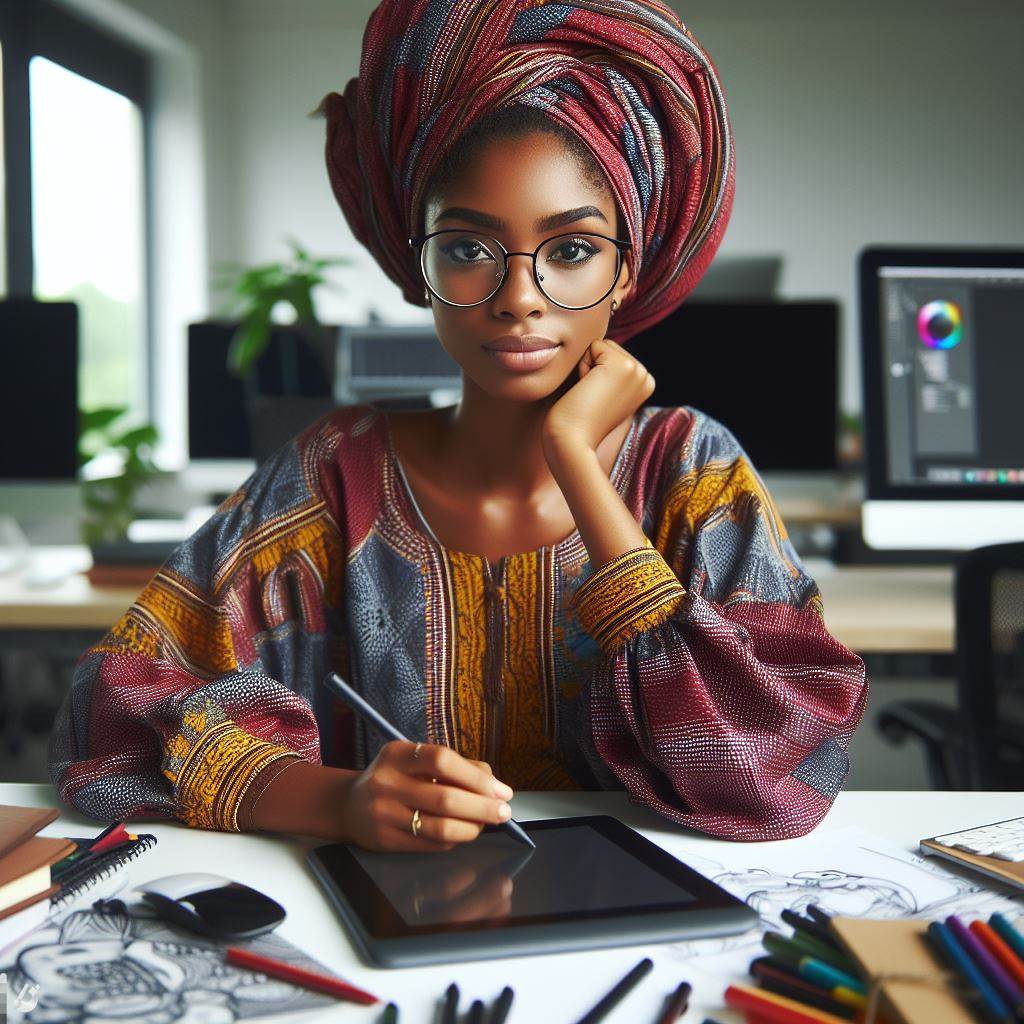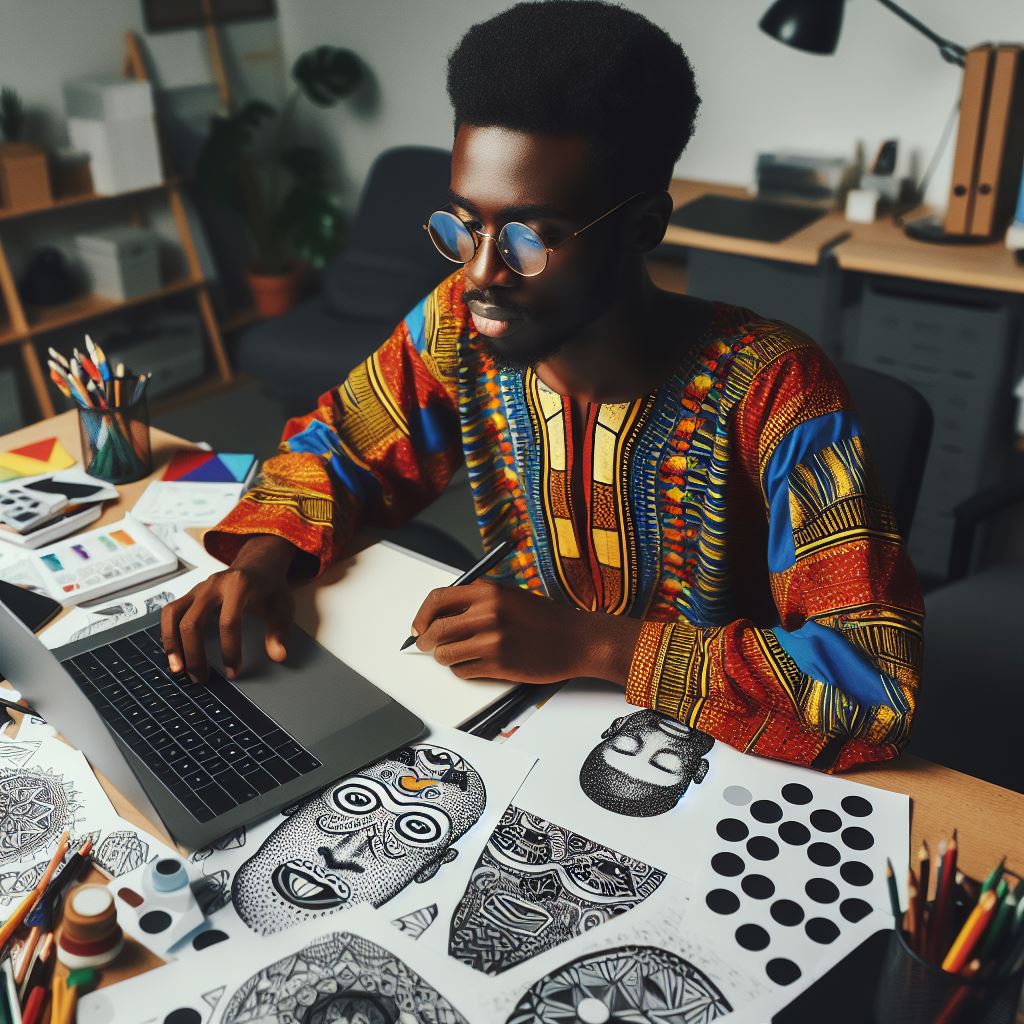Introduction
Graphic design is a visual communication tool that involves combining art and technology.
It plays a vital role in various industries such as advertising, marketing, and branding.
Nigeria is witnessing a growing demand for graphic designers due to the increasing importance of visual content in the digital age.
Graphic design is the art of creating and manipulating visual elements to convey a message or idea.
It involves using various tools and software to create appealing designs that capture the attention of the audience.
In today’s digital world, graphic design has become essential for businesses and organizations to effectively communicate with their target customers.
In industries like advertising and marketing, graphic design plays a crucial role in creating eye-catching advertisements, brochures, and websites.
It helps businesses establish a strong brand identity and communicate their values and offerings to potential customers.
With the rise of social media and online platforms, graphic design has become even more important for creating engaging content that stands out in the crowded digital landscape.
The demand for graphic designers in Nigeria has been steadily increasing over the years.
With the rapid development of technology and the internet, businesses are realizing the importance of investing in quality graphic design to stay competitive.
From startups to established businesses, everyone is recognizing the need for visually appealing designs that captivate their target audience.
In review, graphic design is an integral part of various industries in Nigeria.
Its importance cannot be understated, as it helps businesses effectively communicate their message and establish a strong brand presence.
With the growing demand for graphic designers, it is an exciting time for individuals looking to pursue a career in this field in Nigeria.
Evolution of Graphic Design in Nigeria
Graphic design in Nigeria has undergone a remarkable evolution, transforming from traditional forms to the digital age.
This section provides a historical background of graphic design in Nigeria, explores the role of technology in its transformation, and discusses the introduction of digital graphic design tools.
Historical Background of Graphic Design in Nigeria
- In the early days, graphic design in Nigeria was primarily influenced by traditional art forms and cultural practices.
- Artisans and local craftsmen played a significant role in the creation of visual communications, using manual techniques like painting, carving, and printing.
- The emergence of print media in the late 19th century brought a shift in graphic design practices, with the incorporation of typography and layout principles.
- With the independence of Nigeria in 1960, graphic design took on a more nationalistic identity, reflecting the country’s cultural diversity and political changes.
Role of Technology in the Transformation of Graphic Design
- The advent of technology, particularly the introduction of computers and graphic software, revolutionized the field.
- Graphic designers started to embrace computer-aided design (CAD) tools, which allowed for more precise and efficient creation of visual elements.
- The availability of the internet further expanded the possibilities for graphic designers, facilitating the sharing of ideas and access to global design trends.
- The rise of social media platforms also played a significant role in the promotion and dissemination of graphic design works in Nigeria.
Introduction of Digital Graphic Design Tools
- As technology continued to advance, digital graphic design tools, such as Adobe Photoshop, Illustrator, and InDesign, gained popularity in Nigeria.
- These powerful software applications provided designers with a wide range of creative possibilities, enabling them to produce high-quality designs.
- Designers in Nigeria started to explore various design styles, from minimalistic and modern to traditional and culturally inspired.
- The availability of design tutorials and online courses also contributed to the development and improvement of graphic design skills in the country.
In essence, the evolution of graphic design in Nigeria has been shaped by historical influences, technological advancements, and the introduction of digital tools.
From traditional art forms to digital mediums, Nigerian graphic designers have embraced new techniques and trends.
With technology continuously evolving, the future of graphic design in Nigeria holds even more exciting possibilities.
Read: Master Python in 30 Days: A Nigerian’s Guide
Current Trends in Graphic Design in Nigeria
Graphic design in Nigeria is experiencing a significant transformation, with evolving trends and styles shaping the industry’s future.
Designers are continually pushing boundaries and incorporating innovative techniques to create visually stunning and culturally relevant artwork.
Here are the current trends that have been gaining momentum in graphic design in Nigeria:
Popular styles and techniques in graphic design
- Hand-drawn illustrations: Designers in Nigeria are embracing the charm and authenticity of hand-drawn illustrations. This artistic approach adds a personal touch to graphic design projects.
- Typography experimentation: Nigerian designers are exploring unconventional typography styles, experimenting with different fonts and lettering techniques to create unique and expressive visuals.
- Flat design: Simplified and minimalist design has become popular in Nigeria. Flat design, with its clean lines and vibrant colors, allows for effective communication without unnecessary clutter.
- Motion graphics: Graphic designers in Nigeria are increasingly incorporating motion into their work. Motion graphics add a dynamic element that captivates audiences and delivers engaging messages.
Use of vibrant colors and traditional Nigerian motifs
The use of vibrant colors is a distinguishing characteristic of Nigerian graphic design. Bold, energetic colors are a reflection of the country’s vibrant culture and create visually striking compositions.
Additionally, designers often incorporate traditional Nigerian motifs and patterns into their artwork, celebrating the nation’s rich heritage.
Emphasis on minimalism and simplicity:
A growing trend in Nigerian graphic design is the emphasis on minimalism and simplicity.
Designers are prioritizing clean layouts, clear messaging, and uncluttered visuals, allowing the core message to shine through.
Integration of traditional and modern design elements
Nigerian graphic designers excel at seamlessly blending traditional and modern design elements.
Personalized Financial Consulting – Tailored for You
Get a custom financial plan made just for you in 1-3 days. Clear strategies, actionable steps, and unlimited revisions.
Get StartedThey skillfully incorporate traditional patterns and motifs into contemporary designs, creating a harmonious fusion that reflects the country’s cultural diversity.
As the future unfolds, graphic design in Nigeria will continue to evolve and adapt to new technologies and emerging trends.
The industry will witness further experimentation, creativity, and innovation as designers strive to create visually captivating and culturally relevant artwork.
Read: Powerful Public Speaking Tips
Challenges in the Graphic Design Industry in Nigeria
In Nigeria, the graphic design industry faces several challenges that hinder its growth and development. These challenges include:
These challenges have a significant impact on the graphic design industry in Nigeria.
They hinder its growth, limit the quality of work produced, and discourage talented individuals from pursuing a career in design.
Lack of formal education and training opportunities
Many aspiring graphic designers in Nigeria do not have access to proper formal education or training in the field. This affects their technical skills and overall understanding of design principles.
Lack of formal education and training opportunities is a major hurdle for aspiring graphic designers.
Without proper training, designers may struggle to grasp design principles, typography, color theory, and other essential skills necessary for the profession.
This knowledge gap affects the overall standard of graphic design in Nigeria.
Limited access to design software and technology
Due to financial constraints, designers often struggle to acquire the necessary design software and technology.
This limitation hampers their ability to keep up with the latest industry trends and deliver high-quality designs.
Another challenge is the limited access to design software and technology.
Unlock Your Path to Financial Freedom
Personalized savings and investment strategies tailored to your financial goals. Let's help you take control of your future with a plan designed just for you.
Get StartedDesigners often rely on outdated or pirated software due to its high cost, which hampers their ability to stay updated with the latest design trends.
Additionally, inadequate access to computers and the internet further widens the technology gap in the industry.
Pricing and payment issues in the industry
Graphic designers in Nigeria often face challenges with pricing their services appropriately. Many clients undervalue the importance of design and are reluctant to pay fair prices for creative work.
This leads to low income and financial instability for designers. The pricing and payment issues faced by graphic designers in Nigeria contribute to the undervaluation of their work.
Clients often negotiate for lower prices or delay payments, impacting the financial stability of designers.
This discourages professionals from investing in their skills or acquiring better tools, resulting in a vicious cycle of low-quality designs.
Competitiveness and client expectations
The graphic design industry in Nigeria is highly competitive, with many talented designers vying for limited opportunities.
Additionally, clients’ expectations are often unrealistic, demanding high-quality designs within tight deadlines and low budgets.
Competitiveness within the industry is intense, and client expectations often exceed realistic boundaries. Many clients expect top-notch designs, fast turnaround times, and low prices.
These unrealistic expectations put immense pressure on designers, often leading to compromised quality and creativity.
To address these challenges and ensure a promising future for graphic design in Nigeria, several measures can be taken:
- Improved access to formal education and training programs specific to graphic design will equip designers with essential skills.
- Government support and grants can be provided to help designers access design software and technology at affordable prices.
- The industry needs to educate clients about the value of quality design and fair pricing to change their mindset and improve working conditions for designers.
- Designers should network, collaborate, and support one another to collectively raise the standard and competitiveness of the industry.
In short, the graphic design industry in Nigeria faces various challenges, including the lack of formal education, limited access to technology, pricing issues, and competitiveness.
However, by addressing these challenges and implementing the suggested measures, the future of graphic design in Nigeria can be brighter, fostering growth, creativity, and success in the industry.
Read: Sales Funnel Strategies Uncovered
Take Control of Your Debt Today
Struggling with debt? Get personalized strategies to pay off your debts, negotiate with creditors, and rebuild your credit. Your path to financial freedom starts here.
Get Help
Opportunities in the Graphic Design Industry in Nigeria
In recent years, the field of graphic design in Nigeria has experienced significant growth and development.
With the increased use of technology and the rising demand for digital marketing and online branding, graphic designers in Nigeria have a range of opportunities to explore.
In this section, we will discuss some of the key opportunities in the graphic design industry in Nigeria.
Rising demand for digital marketing and online branding
- Nigeria’s digital landscape is expanding rapidly, leading to a surge in demand for digital marketing services.
- Graphic designers who specialize in creating visually appealing and engaging digital content are in high demand.
- The ability to design eye-catching social media posts, website banners, and online advertisements is crucial.
Collaboration with local businesses and startups
- Nigeria has a thriving entrepreneurial ecosystem, with many local businesses and startups emerging.
- Graphic designers can collaborate with these companies to build their brand identities and visual communication materials.
- Creating logos, packaging designs, and marketing materials for emerging businesses can be a rewarding opportunity.
Opportunities for freelance and remote work
- The graphic design industry offers flexibility for professionals to work from anywhere, including the comfort of their homes.
- Freelancers can take advantage of online platforms to find clients both within Nigeria and internationally.
- Remote work allows graphic designers to offer their services to clients worldwide, expanding their opportunities and client base.
Potential for international recognition and exposure
- Graphic designers in Nigeria have the possibility to gain international recognition for their work.
- Participating in design competitions, exhibitions, and conferences can provide exposure to a global audience.
- Recognition from international organizations and collaborations with foreign companies can open doors to exciting opportunities.
In general, the graphic design industry in Nigeria is full of opportunities for professionals to showcase their skills and talents.
The rising demand for digital marketing and online branding, collaboration with local businesses and startups, as well as the potential for freelance and remote work, all contribute to the growth of this field.
Furthermore, the chance for international recognition and exposure offers graphic designers in Nigeria the prospect of reaching a global audience.
As the industry continues to evolve, it is important for graphic designers to stay updated with the latest trends and continuously refine their skills to remain competitive in this thriving market.
Read: LinkedIn for Nigerian Professionals
Conclusion
In closing, the future of graphic design in Nigeria looks promising with a positive outlook for the growth of the industry.
Continuous learning and skill development will play a crucial role in ensuring the industry’s success.
Designers need to stay up-to-date with the latest trends and technologies to remain competitive.
Additionally, the support of the government and educational institutions is vital for the development of the graphic design sector.
By providing resources and funding, they can help nurture talent and create a conducive environment for innovation and creativity.
Moreover, graphic design has the potential to have a significant impact on Nigerian culture and the economy.
Through visual communication, designers can help promote local traditions, values, and craftsmanship.
This, in turn, can contribute to the preservation and promotion of Nigerian heritage.
Furthermore, as businesses increasingly recognize the importance of branding and visual identity, the demand for skilled graphic designers is expected to grow.
This offers opportunities for professionals in Nigeria to contribute to the country’s economic growth and development.
Designers, government, and institutions must collaboratively propel Nigeria’s graphic design future, nurturing growth, fostering learning, and leveraging its potential to shape culture and boost the economy.




